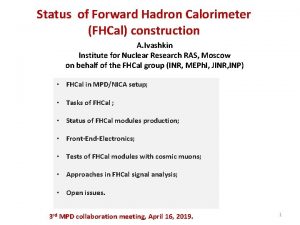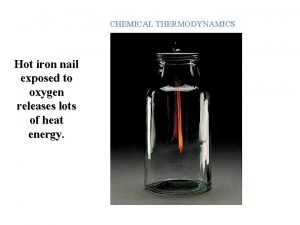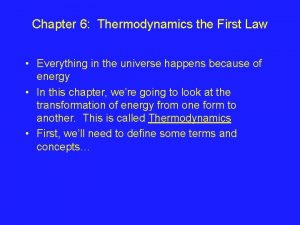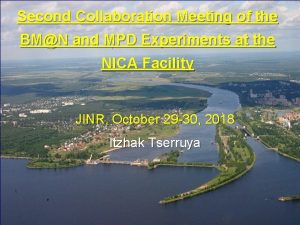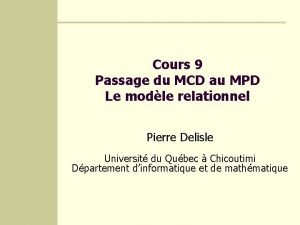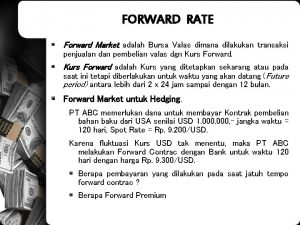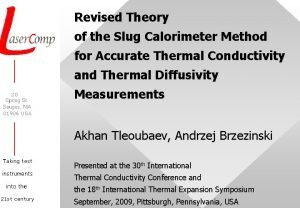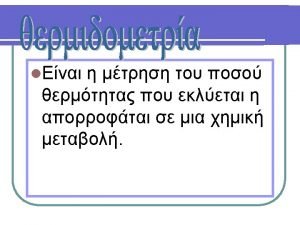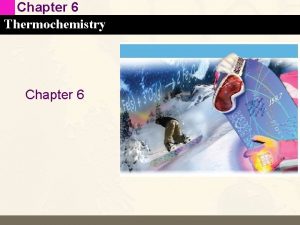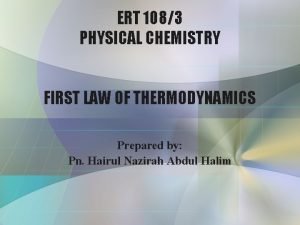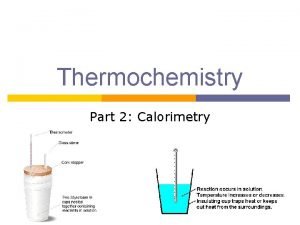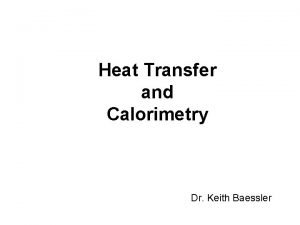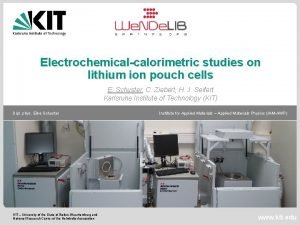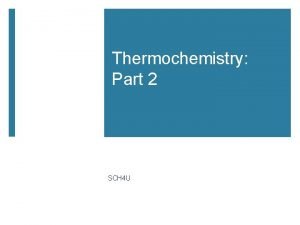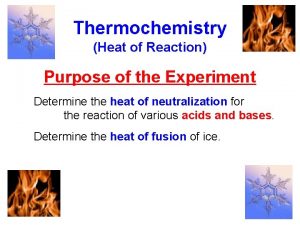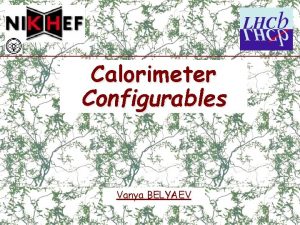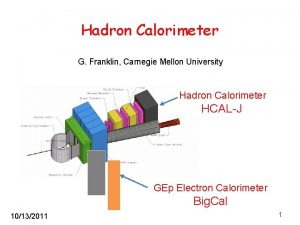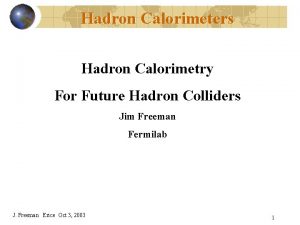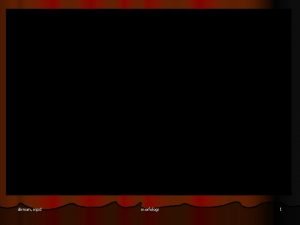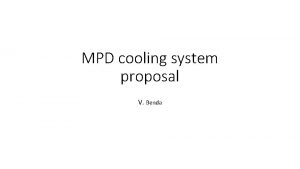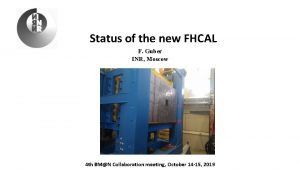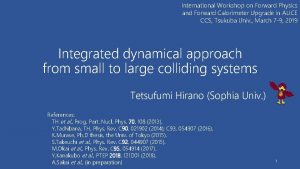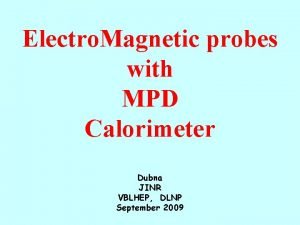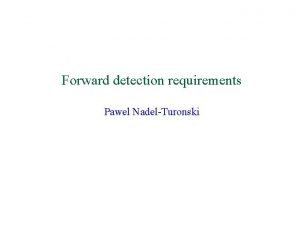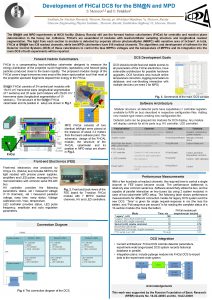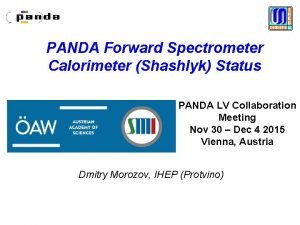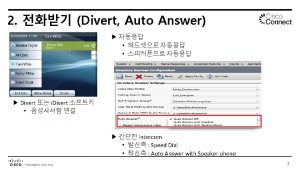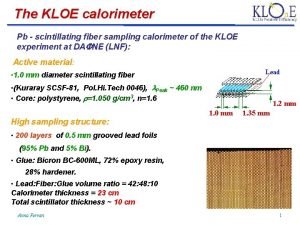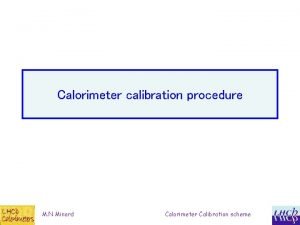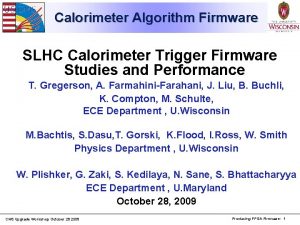Status of Forward Hadron Calorimeter FHCal at MPD






















- Slides: 22

Status of Forward Hadron Calorimeter (FHCal) at MPD A. Ivashkin Institute for Nuclear Researches RAS, Moscow on behalf of the FHCal group (INR, MEPh. I, JINR…) • FHCal in MPD/NICA setup; • Tasks of FHCal ; • Approaches in measurement of centrality; • Status of FHCal production; • Tests of FHCal modules; • Open issues. 2 nd MPD/BM@N collaboration meeting, October 29 -30, 2018. 1

The forward hadron calorimeter in MPD setup Tasks: detection of spectators to measure: a) The centrality of the collision; b) The reaction plane orientation. c) Physics with spectators. FHCAL • Two arms of hadron calorimeters at opposite sides in forward regions. • At the distance 3. 2 meters from the interaction point. • Available acceptance corresponds to pseudorapidity 2. 0< <5. 0 FHCAL consists of 2 x 44 modules of ~1. 1 x 1. 1 m 2 each part.

FHCal will detect the spectators to measure the geometry of ion collisions. Event plane FHCAL Spectator spot • FHCal will detect the energy of spectators ; • FHCal will detect the space distribution of the spectators . • FHCal will detect the energy of pions in forward region ; By using the spectators energy and space distribution one can determine the centrality and the event plane of collisions. 3

Structure of FHCal – two left/right arms. Modular Lead/Scintillator sandwich compensating calorimeter. Sampling ratio Pb: Scint=4: 1. Each arm: • 44 modules; • Beam hole; • Weight – 9 tons. Each module: Light from scintillator tiles is captured by WLS-fibers and transported to Si. PM. • Transverse size - 15 x 15 cm 2 ; • Total length - 106 cm. • Interaction length ~4 λint; • Longitudinal segmentation – 7 sections; • 1 section ~ 0. 56λint; • 7 photodetectors/module; • Photodetectors – silicon photomultipliers (Si. PM). 4

Event plane resolution with FHCal. Event plane in first FHCal arm. Event plane in full FHCal. spectators The detection of all types of the spectators (protons, neutrons) for both colliding nuclei would ensure nice angular resolution of the event plane! 5

Centrality. Problem with energy depositions in FHCAL. Effect of beam hole and escape of heavy fragments. Energy deposition in FHCal isn’t monotonic and can’t resolve the central and peripheral events. Ambiguity in the centrality measurements might be resolved by using the TPC multiplicity. But other approaches are preffered. Resolution of impact parameter for different FHCal energy (centrality) bins. Other approaches are requested! 6

Spectators spots at FHCal surface have different sizes for different centralities. Occupancy of particles at front of FHCal b<6 fm b>6 fm R, cm Cone for central events Cone for peripheral events Eout Ein R, cm The energy deposition in inner and outer parts of calorimeter must be different for different centralities. Let’s introduce energy asymmetry: 7

Centrality measurements with two FHCal observables (Edep and AE). Peripheral events 0. 1 Central events With only FHCal the centrality resolution is below 10% excepting the most central, where the fluctuations of spectator energies dominate. 8

Construction of other observables in FHCal for the centrality measurement. Cone of spectators A bagel structure in ET, EL correlations. 9

Centrality measurements with ET and EL. ts al ntr Ce ts en v le tra en ev n Ce nts e v e ral e h rip e P Each color bin is 10% of centrality. l rip Pe ra he en ev ts Each color bin is 10% of centrality. With only FHCal the centrality resolution is below 10% excepting the most central, where the fluctuations of spectator energies dominate. 10

FHCal: Physics case. n ve le a r t n Ce ts ral e h nts e v e rip e P • These observables would depend on centrality; • These observables would reflect the recoil momenta of the spectators; • These observables would be different in different physics models; • Can spectators probe the fireball ? 11

Status of FHCal modules production. At present, about 2/3 of FHCal modules are ready for the tests. All FHCal modules will be ready next year. Tests of modules with cosmic muons are done in parallel with the development of Front-End-Electronics and readout. 12

Photodiodes, FEE and readout electronics. A first samples of FEE with MPPC photodetectors were developed and produced. Front-End-Electronics: Photodetectors: Hamamatsu MPPC: size – 3 x 3 mm 2; pixel -10 x 10 µm 2; PDE~12%. 7 channels: two-stage amplifiers; HV channels; LED calibration source. ADC Integrator Amp MPPC FEE Dt τ ~~20 ns 50 ns Dt ~ 200 ns The readout electronics: FPGA based 64 channel ADC 64 board, 62. 5 MS/s (AFI Electronics, JINR, Dubna). Full readout chain was tested with cosmic muons and at beam! 13

Test of calorimeter modules with cosmic muons. Geometries of muon tracks in FHCal module. Tracks passed through 2, 3 or all of 7 sections were studied. Light yield [ph. e. ] After assembling each module was tested. Light yield depends on WLS-fiber length. Section # Average light yield for 50 modules. 14

Test of calorimeter supermodule at CERN T 9/T 10 line. • Proton momentum range: 2 -10 Ge. V/c • • • Each module has 10 longitudinal sections with 10 Si. PMs at the end (CBM option). Full size 60 x 160 cm 3. Readout electronics – for FHCal. E 2 [Me. V] Muons deposit ~5 Me. V in each section E 2 [Me. V] Calibration of longitudinal sections with beam muons, 6 Ge. V/c Identification of muons – equal energy deposition in first and last half of modules. E 1 [Me. V] Sect. 1 E 1 [Me. V] A [ch] Sect. 2 A [ch] 15

Dependence of energy resolution on supermodule length. Longitudinal profile of hadron shower. Dependence of resolution on module length. p= 6 Ge. V/c Length of 4λI or 7 longitudinal sections is optimum for momentum range 2 -6 Ge. V/c The stochastic term of ~56% is in good agreement with MC results. 16

Open issues. • Mechanical support. The concept only. • Mass-production of FEE and readout. • Simulations: detector performance and physics performance. • Calibration with cosmic muons in real setup. • Software for FHCal data analysis. • Beam quality study with FHCal. • Power supplies. Mounting of readout elements. Full integration to MPD. • Operation manpower. Magnet pole with FHCal. 17

Thank you! 18

Stages of FHCal production: scintillators. FHCal scintillator tiles and modules are assembled in workshop of INR, Moscow. Scintillator tiles with WLS-fibers. Scintillator tiles in TYVEC reflector. Tests of different grooves and reflectors Permanent quality control of scintillator tiles, WLS-fibers and gluing is performing with 90 Sr β-source. 19

Occupancy. 20

Energy spectra. 21

Other FHCal observable for the centrality measurement. Let’s introduce energy asymmetry: Eout Ein Dependence of AE on impact parameter. AE is experimental observable and has clear dependence on centrality. Let’s combine it with energy deposition in FHCal. 22
 Hadron calorimeter
Hadron calorimeter Coffee cup calorimeter vs bomb calorimeter
Coffee cup calorimeter vs bomb calorimeter Constant volume calorimeter
Constant volume calorimeter Calorimeter problems
Calorimeter problems Lhc tantalizing new physics
Lhc tantalizing new physics Hadron
Hadron Hadron collider
Hadron collider Hadron collider
Hadron collider Mpd collaboration meeting
Mpd collaboration meeting Mcd to mpd
Mcd to mpd Currency forward market
Currency forward market Forward rate dan forward market
Forward rate dan forward market Slug calorimeter
Slug calorimeter Constant volume calorimeter
Constant volume calorimeter Bomb calorimeter uses
Bomb calorimeter uses Coffee cup calorimeter equation
Coffee cup calorimeter equation Bomb calorimeter
Bomb calorimeter Bomb calorimeter
Bomb calorimeter Calorimeter
Calorimeter Accelerating rate calorimeter
Accelerating rate calorimeter Benedict's oxy calorimeter
Benedict's oxy calorimeter A 97 g sample of gold at 785
A 97 g sample of gold at 785 Bomb calorimeter uses
Bomb calorimeter uses
